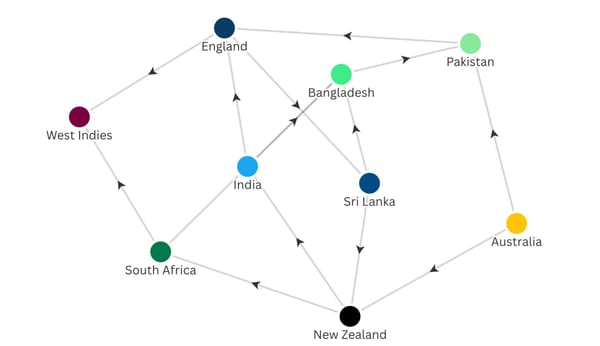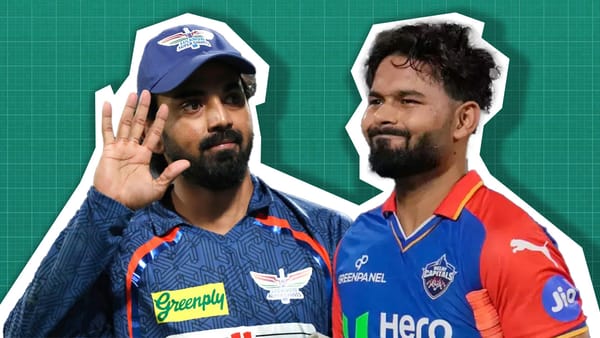England. New Zealand. Afghanistan. Sri Lanka. Anchors. England bowling. Kiwi seam.
Day 17 at the World Cup.
New episode of the Mitch Johnson show is out. Another cracker, get it in you.
England
England are alive.
England didn’t quite bat New Zealand out of the game. They took down the powerplay well, and despite not losing too many wickets, didn’t kick on to the level that they’d have liked. But their bowlers - and perhaps just as importantly their fielders - completely backed them up.
It wasn’t perfect, they certainly would have liked more runs from the middle, a touch more net run rate assistance and Moeen Ali will be thinking about that drop of Glenn Phillips. But they won goddamit, and so that is something.
That it wasn’t a 200 run total that New Zealand could never touch might have been even better. Keeping it as a game. They got everyone out there with the bat, used a good collection of bowlers, and while they were always in front, they still had to bowl and field well.
Also, they just read the game well. With the bat they put the right guys in at the right time, even if that didn’t really matter, as almost all their runs came from the top. With the ball you could see with the fielding positions they had really thought about really specific plans. Their pacers took the speed off the ball, they played the match up game well, and also the dimensions of the ground.
Obviously they are happy to still be in the tournament and all that jazz, but this was also a pretty good work out as well.
Jos
He had some luck, but Jos Buttler has arrived at the T20 World Cup.
Against Afghanistan, his run a ball 18 rather summed up England’s underwhelming effort chasing down a low total. Then against Ireland he got a second ball duck that got England off to the worse possible start in the match that looked like it might end their tournament.
Given the success of New Zealand’s opening bowlers so far in the tournament, England desperately needed a reassuring start from their opening batters – and Buttler and Hales stepped up to provide it.
Buttler was content while Hales was out there to bat a little more cautiously than we are used to seeing him with England. He had just 27 out of the 1st wicket partnership of 81. Then when Hales got out, he moved into a different gear.
There were the moments of luck we have mentioned before. First in the 6th over, he skied Santner and Williamson appeared to take a great catch running backwards. Except he dropped it as he fell to the ground – to be fair to New Zealand though it was they who signalled to the umpires to review it, Jos Buttler had already nearly walked off and had to be stopped by the fourth umpire.
It felt like a crucial moment with Buttler only on 8 and an over later he lapped Ferguson for six. It was at least though an incredibly difficult chance. However it was only the first of two times Buttler was dropped and the same could not be said of the second.
That time it was Mitchell in the 13th over, spilling a sitter in the deep off Ferguson, a fairly unforgivable error at this level. Buttler had made 40 at that point. He’d go on to make 73 from 47 balls.
After the rain against Ireland, England probably feel they were due a bit of luck, and Buttler certainly cashed in. His innings complete with the sort of ludicrous shots that he makes look commonplace – the strength of his wrists through some of the hits to the boundary the most remarkable thing, helping him to place the ball perfectly.
England needed a calming innings from their captain today and Buttler managed to deliver just that. This has been a tournament of ‘anchors’ and while Buttler is too explosive to ever be labelled that, this felt like his version of it, an innings that prioritised calm and stability over simply maximum boundary hitting.
England in the field
England have long known what the weaker side of their T20 game is. It’s their bowling. Today though they were reasonably impressive – as much for keeping their nerve as anything else.
They showed early on that they weren’t afraid to innovate, Moeen Ali being given the first over – a success given it only went for 4. And then Adil Rashid also being given a twirl inside the powerplay, not something England opt for all that often.
They will be pleased to see Chris Woakes bounce back from his pasting against Ireland. First with the wicket of Conway to get things started off, but then to come back and get Mitchell late on to make sure New Zealand didn’t pull of a dramatic comeback. England have had more than enough experience of what Daryl Mitchell can do them recently.
Mark Wood again bowled with huge pace, touching 154.7kph (96mph) at one point, although his most impressive over came later on. He had been good but expensive in his first two overs, and although he had been unlucky not to get a wicket, they had cost 22.
His third was superb, it went for just 3 when New Zealand needed 57 from 30 (with 7 wickets left) and he got the wicket of Neesham. By the end of the over, they needed 54 from 24 and England would have finally felt a little more relaxed about winning the game.
When you throw in Sam Curran’s 2/26 at 6.5 an over, it was an all round excellent performance with England in the field.
Kane’s Anchor
This has been the season of the Anchor. We have seem some very odd innings help teams win in this tournament so far. But obviously a lot of those have been dependent on the conditions. On a thrice used pitch, where cutters should be harder to get away, and your lower middle order might struggle with legspin and high pace. Allowing the rate to get that far away at one end only was not an ideal way of going about it.
Put it this way, Williamson faced a third of the legal deliveries. He scored 40 runs in them.

Phillips faced less balls and made 28 more runs. So he took up 33% of the deliveries and made 26% of the runs.
But perhaps the other important thing is to have a look at how many runs they needed, because one man faced a third of the innings, and he made 22% of the runs.

Here is probably the best way to look at it. Williamson went at a run a ball, the rest of the team went at just under 1.5 runs a balls. Which is almost exactly what was required. But because of Williamson, they would have needed to score at 1.75 runs per ball. If you need that expanded, that’s 1.5 extra runs per over that his teammates had to score.

Now, no one is trying to bat at a run a ball. And Williamson would have backed himself to bat long and then make up for it at the end. The problem with the catchup is when you don’t, not on those occasions you do.
The other questions is whether he could have caught up anyway today. It is how he used to play, before the elbow injury. He was never a power player, but he has a couple of nice years in terms of strike rate.

But the last two have not been. He’s barely above run a ball this year. Last year he was 119.
And to catch up, you need to be able to smash it at the end. Today New Zealand needed 1.5 runs per ball all match, well this year with 50 balls at the death, his strike rate has been 140.

His lowest, by some distance, ever. So would he have ever been able to catch up?
And the anchor thing is obviously a complicated topic. Could Williamson have steadied the ship in a way that allowed the others to score big? Possibly. If he wasn’t out that ball could he have scored a bunch of boundaries and put pressure on England? I don’t know, maybe. But would say Mitchell have played a similar innings, and still had the power to cash in, maybe, But he was 22 from 24 last game. But Williamson was eight from 13. And against Australia he was 23 from 23. So his current strike rate in this tournament is below run a ball. The same as it was in the IPL.
And yet, he is still Kane Williamson.England still cheered his wicket, even as it seemed to make their victory less likely.
There is one other thing I want to mention here, we use anchor really interchangeably. You can average 35 and strike at 130 and be an anchor. And usually anchors, like everyone else, on decent surfaces, score a little quicker. This was an interesting pitch, but if a run a ball is the best he can do, then he’ll have to fart rainbows from here on in as a captain.
Kiwi seam bowlers
This tournament, the powerplay has been all about the seamers. In fact, as I’ve discussed before, since Kookaburra changed the seam, almost seamers are massively more impactful at the top compared to before. And one team that has affected more than most has been New Zealand.
Coming into today they were averaging way below 20, and no one else was even close.

There was some slight regression in this match, but they’re still around two runs a wicket less than other teams. It means if you are playing them, your middle order is going to be under more pressure than most teams.
But this was a thrice used pitch, and unlike many of the other surfaces we have seen in this tournament, it wasn’t as helpful for the new ball. And you could see that in the Boult Southee figures tonight compared to the other games.

It shows a couple of things, how different each venue is, even from game to game. I talked about this on the podcast with Bharat.
It’s a good show actually, we talk about the reasons Pakistan have been terrible. Look at how interesting and fun this tournament has been. Look at Ireland and Bangladesh. Plus a few other things.
But ground dimensions, weather, the fact the wickets are unprepared, and even as we reuse them there is more variety in this tournament so far than you would expect in Australia.
But it also shows that while New Zealand have been winning with wickets at the top, they were not out of the game when that didn’t happen today, their attack is varied and intriguing. And while their batters came up short, considering their start, the bowlers did pretty well.
Afghanistan
Of all the teams affected by the rain, Afghanistan have had the worst of it in this tournament. After a gap of ten days they were undoubtedly just pleased to be able to get out and play.
Unfortunately that was about as good as it got for them, they never really got going in this match. All of their top four made starts, but never batted at a pace to really worry Sri Lanka. And that was despite Gurbaz in particular striking some very sweetly hit boundaries, including a glorious lofted drive down the ground for six.
It seemed a mistake that Mohammad Nabi and Rashid Khan, players both capable of upping the scoring rate, didn’t come out to bat for so long. Sadly for Afghanistan the most notable moment of their innings came via the run out of Gulbadin.
Sent back when attempting a second run, Gulbadin slipped, dropped his bat and then tragically tried and failed to roll back into his crease – he went off making the most of pretending he’d hurt his arm doing it, but it didn’t help to restore much face unfortunately. Another excellent entry into the Gulbadin canon.
With the ball, Afghanistan struggled to find much penetration outside of Mujeeb and Rashid Khan. Although Fazalhaq Farooqi bowled well without much reward.
When Mujeeb struck early they would have been feeling optimistic, but chasing a low target, Sri Lanka never really had to take any risks and Afghanistan struggled to build any real pressure.
To add insult to injury or rather injury to insult, Rashid Khan fell nastily fielding the ball on the boundary, off the penultimate ball of the match. He looked to have hurt his knee and had to be carried off limping – didn’t look great for their next match against Australia.
Sri Lanka
Sri Lanka delivered their most polished performance of the tournament, although still found time for a couple more dropped catches.
After Afghanistan enjoyed a good powerplay, their bowlers did well to peg them back and they were always ahead of the game once they restricted them to 144.
Hasaranga was superb, going at just 3.3 an over and picking up 3/13 – a bonus for him in that included deceiving his ‘opposite number’ Rashid Khan with an excellent googly. He was absolutely pumped up at all times in the field as well.
Sri Lanka could have been rattled by the early wicket of Nissanka, but they kept their cool. Dhanajaya de Silva looked fantastic, he didn’t panic despite starting slowly and was able to change gear decisively later on.
He slog swept Rashid Khan for a six which seemed to get him going and he hit 54 off his last 29 balls, finishing 66* from 42 – as Sri Lanka eventually won fairly comfortably to keep their World Cup hopes alive going into the final game.




